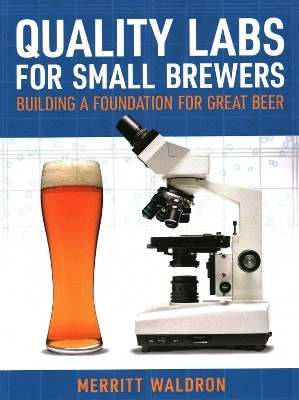
Quality Labs for Small Brewers
Brewers Publications (Verlag)
978-1-938469-63-3 (ISBN)
- Titel z.Zt. nicht lieferbar
- Versandkostenfrei
- Auch auf Rechnung
- Artikel merken
A good quality program has many moving parts but it is underpinned by good manufacturing practice (GMP) and food safety requirements. GMP covers every aspect of a brewery's operation, not just how personnel comport themselves, but how goods in are handled and stored, how beer is held in the warehouse, and how equipment, plant, and the grounds are maintained. Learn how to set standards and critical control points, and how to effectively monitor your process so that any deviation is quickly addressed.
Discover how policies, procedures, and specifications can help ensure quality throughout every process. Involve your staff in establishing standard operating procedures, corrective actions, and improvements. Learn how to effectively delegate responsibility and also ensure that management is armed with the information they need to ultimately make what may be some tough decisions. If the worst happens, understand that being able to make a tough call and having a robust recall procedure in place means you can move quickly to rectify matters, which helps your brewery retain the confidence of your customers and distributors.
Brewers will see results through the application of GMP and food safety prerequisite programs. Your quality manual laying out standard operating procedures, product specifications, and corrective action plans will give your staff the confidence to implement your quality program. With these programs in place, the author then takes you through each area of your brewery operation and breaks down how key parameters are measured and analyzed at critical control points. Sampling plans are outlined for monitoring density, temperature, pH, yeast viability and growth, alcohol, carbonation, dissolved oxygen, titratable acidity, fill height, and packaging integrity. Explore setting up an effective sensory panel, even a small one, that will help ensure each beer remains true-to-brand. Waldron outlines building your brewery laboratory and looks at how to implement an in-house microbiology program. Throughout this, the focus is on scaling your efforts to the size of your operation and always being ready to expand your quality program as your brewery grows. The author makes it clear that no brewery is too small to implement QA/QC and discusses pragmatic solutions to building out your capabilities.
Beyond taking meaningful, accurate measurements, the author also explores how to analyze data. Learn some basics of statistics and data organization and how to apply these techniques to continuously monitor processes and spot when corrective action is needed. These routines will help pinpoint any risks or areas of improvement and ensure that only quality beer reaches the customer, time after time.
Combining his passion for science and craft beer, Merritt Waldron grew the quality program at Rising Tide Brewing Company in Portland, Maine from 900 to over 5,000 barrels. An avid homebrewer for 15 years, Merritt holds a degree in physics from the University of Southern Maine. He is highly active in the brewing community and speaks about quality at the Craft Brewers Conference, MBAA district meetings, and the New England Craft Brew Summit. Merritt is currently Quality Director at Baxter Brewing Co. and resides with his wife in Portland, Maine.
Table of Contents
Introduction
About the book
What I assume about the reader
What's this Quality Control Thing About Anyway?
Quality Control
Quality Assurance
Quality System
The Structure
Part I – Building a Solid Foundation
Chapter 1 – Food Safety Modernization Act
Introduction
Food Safety Terms
What FSMA Means for Craft Brewers
What if My Facility is a Brewpub?
How Do I comply?
Chapter 2 - Good Manufacturing Practices
What are Good Manufacturing Practices?
GMPs vs. SSOPs
Familiarize Ourselves with GMP Requirements
Personnel
Plants and Grounds
Sanitary Operations
Sanitary Facilities and Controls
Equipment and Utensils
Warehousing and Distribution
Holding and Distribution of Human Food By-Products
Defect Action Limits
Culture of Food Safety and Quality First
Writing a GMP Manual
Next Steps, Auditing
Chapter 3 – Food Safety Program
Common Food Safety Hazards Around the Brewery
Physical Hazards
Chemical Hazards
Biological Hazards
Control Points and General Control Methods
Assemble Your GMP/Food Safety Team
Put it in Writing
Monitoring Principles
Critical Control Limits
Recall Planning
General notes About Your Recall
Recall Plan in Seven Steps
Things to Add to Your Food Safety Program
Chapter 4 – Standard Operating Procedures (SOPs)
Writing an SOP
Supporting Components
Using a Template
Implementation, Training, and Upkeep
Chapter 5 - Cleaning and Sanitation
Cleaning
Sanitation
Application Variables
Part II – Starting Your Quality Program
Chapter 6 – Starting Your Quality Program
Planning Your Program
Safety
Identifying Quality Control Points
Sampling Plan
Pulling it all Together
Chapter 7 - Writing a Quality Manual
Quality Policy
Quality Governance and Management
Standard Procedures
Specifications of Finished Products
Consumer and In-house Complaints
Corrective Action Plan
Master Sanitation Schedule
Good Laboratory Practices
Calibration Plan
Conclusion
Part III - Measurement
Chapter 8 - Weight, Volume, Concentration, and Dilution Equations
Basic Volume Calculations
Area
Volume
Volume and Temperature Relationship
Volume, Density, and Weight
Problem Solving by Dimensional Analysis and Unit Conversions
Making a Standard Solution
Serial Dilution
Mixing Equation
Scaling
Chapter 9 – Density
Specific Gravity and Plato
Where to measure
Sampling Plan
Troubleshooting
Chapter 10 – Temperature
Temperature Scales
How to Measure
Where to Measure
Sampling Plan
Troubleshooting
Chapter 11 – pH
pH: A Closer Look
Hydrogen Ion Sources
Buffers
How to Measure
Where to Measure
Sampling Plan
Troubleshooting
Chapter 12 – Yeast
Yeast Management
How to Measure
Microscope Basics
Getting to Know Your Hemocytometer
Viability & Methylene Blue
Limitations and Counting Rules
Serial Dilution
ASBC Yeast-3
Craft Brewers Quick Method
Pitch Rate
Where to Measure
Sampling Plan
Troubleshooting
Chapter 13 – Sensory
What is Sensory Analysis
Sensory Program
What We Measure
Practice
Developing Brand Recognition – True to Brand
Getting Formal
Data Collection Forms
Data Collection
Flavor Standards/Off-Flavors
Goal Setting
Conclusion
Chapter 14 – Microbiology
Concerns of Brewers
Ingredients
Environment
Sterilization
Aseptic Technique
Traditional Plating Culture
Choosing the Right Media
Building Confidence in Your Results
Plating Methods
I Have Growth on My Plates! What's Next?
Yeast Identification
Bacteria Identification
Document Results
Next Steps
Advanced Methods
Bringing PCR Into Your Brewery
Chapter 15 - Packaging Quality
Receiving Packaging Materials
Fill Height
Closures
Can Seam Measurements
How to Measure Can Seams
Sampling Plan
Bottle Seals
Secondary Tests
Date Coding
Container Lot Tracking
Labeling
Chapter 16 - Carbon Dioxide
Henery's Law
Units
Where it is Measured
How is it Measured
Where to Measure
Troubleshooting
Chapter 17 - Dissolved Oxygen
Where to Measure
Sampling Plan
Troubleshooting
Chapter 18 - Alcohol
How to Measure
Where to Measure
Sampling Plan
Troubleshooting
Chapter 19 – Titrations
Preparing for a Titration
Titration of a Strong Acid with a Strong Base
How to Measure
Where to Measure
Troubleshooting
What is it used for?
Chapter 20 – Spectrophotometry
Principles of Measurement
How to Measure
Where to Measure
Chapter 21 – Turbidity
Units
How to Measure
Where to Measure
Part IV – Getting To Work
What Every Brewery Should Measure and Document
Chapter 22 – Setting Up Your Brewery Lab
One Goal, Different Approaches
The Retro Fit Approach
The Collector Approach
The Build Out Approach
Budgeting
Lab Safety
Chapter 23 – Introduction to Analysis
Variables
Plan-Do-Study-Act Cycle
Conclusion
Chapter 24 – Data Collection
Accuracy and Precision
Sources of Error
Mean, Normal Distribution, and Standard Deviation
Normal Distribution of Data
Chapter 25 – Data Organization and Analysis
Developing Brew Logs
Analyze Your Data
Getting Data on the Spreadsheet
Charting Best Practices
Moving Range Chart
Chapter 26 – Plan-Do-Study-Act Cycle
PDSA Example Case Study
Setting Product Specifications
Chapter 27 - Continuous Improvement
Where do I Start?
Continuous Improvement in Your Future
Chapter 28 – Conclusion
Final Words of Advice
Appendix A – Basic Good Manufacturing Process Example
Appendix B – GMP Audit Checklists
Appendix C – Food Safety Plan Templates
Appendix D – Recall Planning and Procedure
Appendix E – How to Write an SOP
Appendix F – SOP Example – Equalibriated Package Dissolved Oxygen Samples
Appendix G – How to Use a Hydrometer
Appendix H – ASBC pH Fishbone XXb
Appendix I – SOP Forward Pipetting Technique
Appendix J - SOP_Forward_Pipetting_Technique
| Erscheinungsdatum | 10.05.2021 |
|---|---|
| Verlagsort | Boulder, CO |
| Sprache | englisch |
| Maße | 214 x 277 mm |
| Gewicht | 658 g |
| Themenwelt | Sachbuch/Ratgeber ► Essen / Trinken ► Getränke |
| Technik ► Maschinenbau | |
| ISBN-10 | 1-938469-63-1 / 1938469631 |
| ISBN-13 | 978-1-938469-63-3 / 9781938469633 |
| Zustand | Neuware |
| Informationen gemäß Produktsicherheitsverordnung (GPSR) | |
| Haben Sie eine Frage zum Produkt? |
aus dem Bereich


